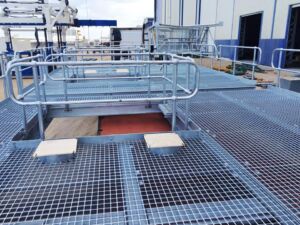Steel grating and fiberglass grating are two popular materials for various industrial applications. Both have their own advantages and disadvantages, and it’s important to understand the differences between them in order to make an informed decision for your specific needs.
Steel grating is made of steel bars that are welded together to form a grid pattern. It is known for its strength, durability, and load-bearing capacity. Steel grating is commonly used in industrial flooring, catwalks, I Type Fabricate grătare din oțel, and other applications that require heavy-duty support.

On the other hand, fiberglass grating is made of reinforced fiberglass and resin. It is lightweight, corrosion-resistant, and non-conductive, making it ideal for applications where electrical insulation is required. Fiberglass grating is commonly used in chemical plants, water treatment facilities, and offshore platforms.
When comparing steel grating vs fiberglass grating, one of the key factors to consider is the material’s resistance to corrosion. Steel grating is susceptible to corrosion, especially in harsh environments where it is exposed to moisture, chemicals, and extreme temperatures. In contrast, fiberglass grating is highly resistant to corrosion, making it a preferred choice for applications where corrosion is a concern.
Another important factor to consider is the material’s weight. Steel grating is much heavier than fiberglass grating, which can make installation more challenging and increase labor costs. Fiberglass grating, on the other hand, is lightweight and easy to handle, making it a cost-effective option for projects that require quick and easy installation.
In terms of maintenance, steel grating requires regular inspections and maintenance to prevent corrosion and ensure structural integrity. This can add to the overall cost of ownership and maintenance. Fiberglass grating, on the other hand, is virtually maintenance-free, requiring minimal upkeep and reducing long-term costs.

When it comes to safety, both steel grating and fiberglass grating have their own unique properties. Steel grating provides excellent slip resistance, making it a safe choice for industrial flooring and walkways. However, it can become slippery when wet or oily, posing a safety hazard. Fiberglass grating, on the other hand, offers superior slip resistance, even in wet or oily conditions, making it a safer option for applications where slip resistance is a priority.
In terms of cost, steel grating is generally more affordable than fiberglass grating in terms of initial purchase price. However, when considering long-term costs, including installation, maintenance, and replacement, fiberglass grating may offer a more cost-effective solution. It’s important to weigh the upfront costs against the long-term benefits when making a decision between steel grating and fiberglass grating.
In conclusion, both steel grating and fiberglass grating have their own unique properties and advantages. When comparing steel grating vs fiberglass grating, it’s important to consider factors such as corrosion resistance, weight, maintenance, safety, and cost. By understanding the differences between these two materials, you can make an informed decision based on your specific needs and requirements.

